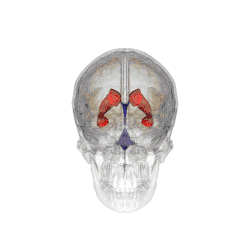Lateral recess
| Lateral recess | |
|---|---|
 Diagram showing the positions of the three principal subarachnoid cisternæ. (Lateral recess not labeled, but region is visible.) | |
| Details | |
| Identifiers | |
| Latin | recessus lateralis ventriculi quarti |
| NeuroNames | 642 |
| TA98 | A14.1.05.717 |
| TA2 | 5968 |
| FMA | 78470 |
| Anatomical terms of neuroanatomy | |

Three-dimensional representation of the ventricular system of the human brain. The fourth ventricle is the lower blue mass. The little points sticking out on the left and right are the two parts of the lateral recess.
The lateral recess is a projection of the fourth ventricle which extends into, or rather below, the inferior cerebellar peduncle of the brainstem.[1]
The lateral aperture (Foramen of Luschka), an opening in each extremity of the lateral recess, provides a pathway for cerebrospinal fluid to flow from the brain's ventricular system into the subarachnoid space. The lateral aperture is the end point (and opening or foramen) of the lateral recess. Consider the lateral recess as a tunnel whose opening at one end is the lateral aperture.
In the area of the lateral recess, the vestibular area (containing the vestibular nuclei) and the cochlear nuclei may be found. In the vicinity, the medullary striae may also be seen.
References
- ↑ Standring, Susan (2016). Gray's anatomy: the anatomical basis of clinical practice (41 ed.). Elsevier Limited. pp. 271–279. ISBN 978-0-7020-5230-9.
This article is issued from Offline. The text is licensed under Creative Commons - Attribution - Sharealike. Additional terms may apply for the media files.